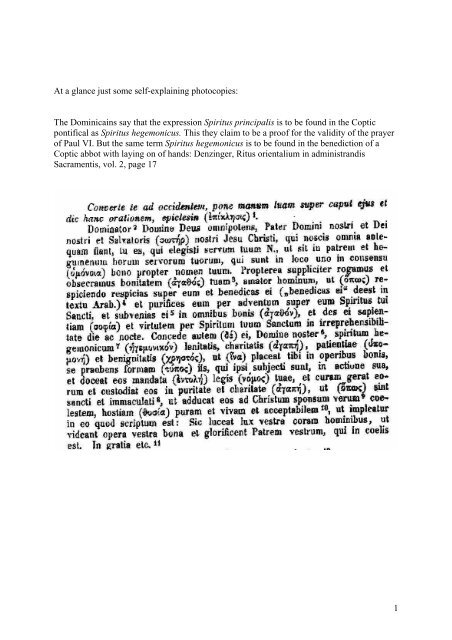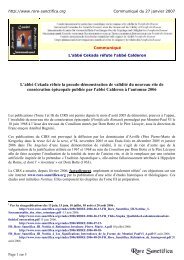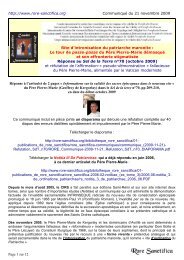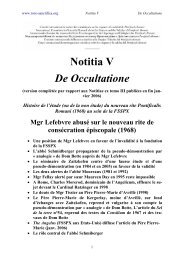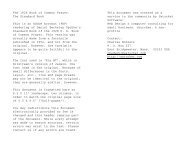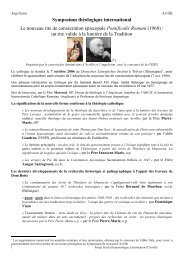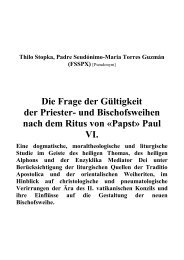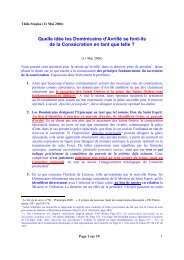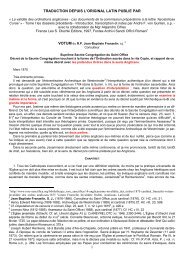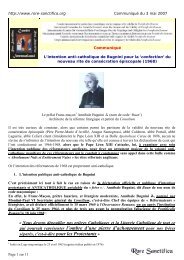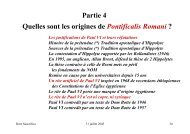Thilo Stopka - Texte aux redemptoristes «At a Glance - Rore Sanctifica
Thilo Stopka - Texte aux redemptoristes «At a Glance - Rore Sanctifica
Thilo Stopka - Texte aux redemptoristes «At a Glance - Rore Sanctifica
You also want an ePaper? Increase the reach of your titles
YUMPU automatically turns print PDFs into web optimized ePapers that Google loves.
At a glance just some self-explaining photocopies:<br />
The Dominicains say that the expression Spiritus principalis is to be found in the Coptic<br />
pontifical as Spiritus hegemonicus. This they claim to be a proof for the validity of the prayer<br />
of Paul VI. But the same term Spiritus hegemonicus is to be found in the benediction of a<br />
Coptic abbot with laying on of hands: Denzinger, Ritus orientalium in administrandis<br />
Sacramentis, vol. 2, page 17<br />
1
Compare this with the Coptic Pontifical for the consecration of a bishop, Denzinger, page 24:<br />
Note that the Coptic pontifical is clearly speaking that the bishop must “constituendi cleros<br />
secundum mandatum ejus ad sanctuarium”. Now have look at the version which Dom Botte<br />
introduced into the Consilium, which is the file containing the results of the preparing<br />
commission in 1967, page 53, the following text:<br />
He erased the part “constituendi cleros secundum mandatum ejus ad sanctuarium” and<br />
shortened it to “dimittendi peccata secundum mandatum ejus ad sanctuarium”. Although the<br />
Dominicans did not use this text, they neither revealed this fake. The faked text is to be found<br />
in the archives of Trève (Trier, German Liturgical Institute), where Father Pierre Marie went<br />
with Father Gaudron. What did they do there?<br />
2
On page the 100 of LE SEL DE LA TERRE we are learning that Dom Cagin presents a text<br />
from Denzinger, the ordination of a Maronite metropolitain. Dom Cagin tells us, where the<br />
text is to be found in Denzinger’s book, which the Dominicans mention, too. The way Avrillé<br />
is presenting the indication misleads the reader to the idea that we are talking about a valid<br />
sacramental prayer for laying on of hands<br />
3
This prayer is similar to the one of Paul VI., but is it a prayer for the laying on of hands? If we<br />
follow the pages in Denzinger’s book, which are indicated by Dom Cagin, we only find<br />
general notes on page 108 and on page 200 we find a prayer to anoint the head of the ordained<br />
(caput ordinati):<br />
4
In fact, this text is not speaking of the power of ordination, but mentions the confirmation<br />
instead. The editors of this rite saw maybe an analogy and a link between the unction of the<br />
head and the sacrament of confirmation. The two prayers for the laying on of hands are to be<br />
found elsewhere in the pages 194 and 195. Do the Dominicans describe them?<br />
5
The second prayer, bottom page 194 – top page 195:<br />
Gratia divina et coeleste donum Domini nostri Jesu Christi, quae omni tempore implet<br />
defectus nostros et sanat infirmitatem nostram ac nostra alligat vulnera nostrosque dimittit<br />
reatus et curam gerit omnium filiorum sanctae Dei ecclesiae, vocat et promovet hunc N.,<br />
servum Christi qui hic adest et cum timore, tremore ac fide vera animam suam coram sancto<br />
altari humiliavit et oculos mentis suae in altum attollit ad te, qui habitas coelis coelorum, et<br />
expectat donum coeleste a gradu presbyterorum .......ad gradum episcoporum......<br />
The same sort of game like with the ordination of Maronite Metropolitan is played with us in<br />
the same page 100 of LE SEL DE LA TERRE, when they talk about the ordination of a<br />
Coptic Metropolitan. In fact, this ordination is a supplement to the bishop consecration and<br />
conferred at the end of the liturgy. The rubrics clearly say “postremo”. Let’s have a look at<br />
Denzinger, page 33:<br />
6
The rubrics do not even mention a laying on of hands. So again this prayer, which resembles<br />
to the one of Paul VI. In style is no proof of tradition. But still, none of those prayers is<br />
fostering the unctionism of Paul VI.<br />
Let’s now speak about one of the worst cases of falsification: the change of quam to quem of<br />
in page 220 of Denzinger’s book. The Dominicans pretend in page 125 of LE SEL DE LA<br />
TERRE that they looked it up the text themselves and quote Denzinger directly without<br />
saying, that they got the quotation from Dom Cagin and Dom Botte.<br />
7
So, this is the real text on page 220 and the phrase “quem tradidisti dilecto Filio..” is not to be<br />
found, but we read “quam tradidisti…”. The meaning changes completely. Compare it to the<br />
table the Dominicans present on page 125 of LE SEL DE L’ENFER:<br />
8
I call this cheating! WHAT DO YOU SAY? Both texts are falsified, Denzinger’s text is<br />
misquoted and the TESTAMENTUM as well:<br />
10
Let’s consult Rahmani’s edition, page 31<br />
As you can see, Father, also Rahmani confirms the quam and not quem. How about the Syriac<br />
text? Did Denzinger and Rahmani make a mistake? I got it checked in the Suryoyo Online<br />
Forum of Gabriel Rabo, in charge of Syriac Church History at the University of Göttingen in<br />
Germany:<br />
"anhar w'oshud sakultonutho w taybutho hoy d-men ruhokh rishonoyo hoy<br />
d'ashlemt l-abrokh habibo yeshu' mshiho" (Text based on “The Synodicon in the<br />
Western Syriac Tradition”, Voobus, Louvain, 1975)<br />
The relative pronoun hoy in feminine gender is appearing twice. If there should<br />
be something which could confirm the quem instead, the second hoy must be<br />
replaced by haw, which is masculine gender.<br />
If you take the version of Assemani, the text is:<br />
anhar w'oshud 'law (over him) sakultonutho w taybutho hoy dmen<br />
ruhokh rishonoyo hoy d'ashlemt l-abrokh habibo moran (Our<br />
Lord) yeshu' mshiho<br />
The proper translation would be in both cases in Latin:<br />
„illumina et effunde (super eum) intelligentiam et gratiam, quae est e Spiritu tuo principali,<br />
quam tradidisti dilecto Filio (Domino nostro) Jesu Christo...“<br />
The queue of intelligentiam and gratiam is only changed between Rahmani and Denzinger.<br />
This does not change much, since created graces do not constitute Our Lord as Messiah, but<br />
11
this is rather the uncreated Grace of the Union (unfortunately Ludwig Ott is to brief here, you<br />
must consult Diekamp. Maybe one of your brothers has it in German.) Created graces as<br />
accidentia in the mankind of the Redeemer are the consequence and not the principle of the<br />
Hypostatic Union. Neither do those graces constitute the Catholic priesthood in general,<br />
because the character is not considered as a grace and can be received, though as a sacrilege,<br />
without any infused grace. In the case of Our Lord those created grace are always present,<br />
because the Esse divinum of the Logos is also the actus essendi of His human nature. There<br />
are not two actus essendi of the Logos and the mankind. This is a result of the distinction<br />
between Esse and Essentia according to St. Thomas. Otherwise you must follow Suaréz and<br />
Scotus. Thus, created graces are infused with necessity due to the perfection of the uncreated<br />
Grace of the Union, which is the Divine Mission of the Son and not of the Holy Ghost. You<br />
also can see in the graces which are given to Jesus, the power over the treasure of redemption,<br />
which he received in the Incarnation. Anyway, the phrase in question is not a Syriac<br />
sacramental form, but a text-formula in the non-sacramental enthronisation of a patriarch.<br />
Let’s have a look at list of the names of the various prayer for laying on of hands which<br />
Avrillé doesn’t discuss nowhere:<br />
Les impositions des mains divers :<br />
Metropolitain maronite :<br />
• 1) « Gratia divina », Denz, t.2, page 194 – 195<br />
• 2) « Deus, qui universam Ecclesiam tuam », Denz., t.2, page 195<br />
• La prière dans la page 200, qui ressemble à celle de Paul VI et bien là pour oindre le<br />
chef de l’ordonné et n’est pas accompagnée d’une imposition des mains, bien au<br />
contraire de la suggestion d’Avrillé, page 100<br />
Patriarche maronite, ancienne version sacramentelle, qui n’existe plus<br />
• 1) « Deus, qui virtute tua omnia coelesti fecisti », Denz. t.2, page 219<br />
• 2) « Imponimus manus nostras », Denz., t.2, page 219 – 220<br />
• 3) « Deus, qui omnia in virtutue fecisti », Denz., t.2, page 220<br />
Patriarche copte-orthodoxe, version sacramentelle<br />
• 1) « Gratia divina », Denz., t.2, page 47<br />
• 2) « Dominator Domine Deus », Denz., t.2, page 48<br />
• 3) « Imponimus manus nostras », Denz., t.2, page 56, ou 35<br />
• L’ordination d’un métropolitain copte est un rite annexe après les sacré d’un évêque,<br />
sans effet sacramentel. Voir les rubriques, Denzinger, page 33<br />
12
Patriache syriaque, ancienne version sacramentelle, qui n’existe plus. Analyse<br />
synthétique de Denzinger et Dom de Smet, texte et rubriques<br />
• 1) « Deus, qui omnia fecisti potentiam tuam», comme N°1 patriarche maronite, Denz.<br />
t.2, page 97,<br />
• 2) Comme N°3 patriarche maronite, voir indication page 76<br />
• 3) « Imponimus manus nostras », comme N°2 Patriarche maronite, voir l’indication<br />
page 77 chez Denzinger.<br />
Nous insistons ici, que ni les rubriques maronites ni syriaques disent, que l’invocation du<br />
Saint Esprit pour un patriarche doit remplacer celle de l’ordination épiscopale normale, mais<br />
plutôt qu’elle doit être ajouté.<br />
TestSy<br />
• 1) « Imponimus manus nostras », Rahmani, page 29<br />
• 2) « Deus, qui omnia in virtutue fecisti « , Rahmani, page 29-30<br />
Please find enclosed the letter of Mgr Al-Jamil:<br />
Rome le 28 novembre 2005<br />
En réponse <strong>aux</strong> questions posées par :<br />
THILO STOPKA et Par …..<br />
Voici les réponses ( <strong>aux</strong> 6 questions posées)<br />
Il est arrivé une seule fois, le 24 avril 1802, qu’un prêtre ( Père Michel DAHERYE né à Alep<br />
le 27 avril 1761) fut élut Patriarche d’Antioche pour les Syriens Catholiques. Il fut Sacré<br />
évêque le 04 mai 1802 puis à la fin de son Sacre épiscopal, fut tout de suit intronisé<br />
Patriarche. Le degré patriarcale n’est pas une ordination. L’épiscopat est la plénitude du<br />
sacerdoce. Donc après l’épiscopat il n’y a plus d’ordination. Le patriarche comme le Pape<br />
n’ont, après leur élections, que le rite de l’intronisation qui n’est pas du tout une ordination.<br />
+ Mikhael Al Jamil<br />
Archevêque Syrien Catholique<br />
Procureur patriarcal près le Saint Siège<br />
13
Brief von Mgr Younan, syrischer Erzbischof in New Jersey<br />
Dear <strong>Thilo</strong> <strong>Stopka</strong>:<br />
I am responding to your question of last email regarding the Prayer of Invocation of the<br />
Holy Spirit upon the Bishop to be consecrated. In our Church we still use the same prayer<br />
found as you said in the pages 204-205 of the Book of Pontifical Rites, published by<br />
Patriarch (Cardinal) Ignatius Gabriel Tappouni 1952. It was used at my ordination and in<br />
the most recent one in which I took a part as a co-consecrator.<br />
May the Lord bless you and your work for the Church.<br />
+ Mar Ephrem Joseph Younan<br />
Eparch<br />
-----Original Message-----<br />
From: <strong>Thilo</strong> <strong>Stopka</strong><br />
To:<br />
Cc:<br />
Sent: Fri, 21 Oct 2005 09:20:13 +0200<br />
Subject: Reminder: Question on the Syriac-Catholic Pontifical<br />
To His Lordship Mar Ephrem Joseph Younan<br />
502 Palisade Avenue Post Office Box 8366 Union City NJ 07087-8262<br />
France<br />
Dear Mylord,<br />
please have the kindness to answer a short question regarding the Syriac-Catholic pontifical<br />
for the consecration of a bishop. I am working on a study at the moment and I am myself a<br />
Roman Catholic. Is the text underneath still used by the Syriac-Catholic Church, or do you<br />
use now a prayer close to the pseudo-clementine acts?<br />
In the 50ies the Patriarchat at Sharfeh published the following text which is the same like<br />
the Syriac-Orthodox one. The text is translated from pages 204-5 of the Pontifical of<br />
the Antiochean Syrians, Part II, printed in 1952, Sharfeh, Lebanon, and carries the<br />
Imprimatur of Ignatius Gabriel Cardinal Tappuni, Syrian Patriarch of Antioch:<br />
"O God, Thou hast created everything by Thy power and established the<br />
universe by the will of Thine only Son. Thou hast freely given us the grasp of<br />
truth and made known to us Thy holy and excellent love. Thou hast given Thy<br />
beloved and only-begotten Son, the Word, Jesus Christ, the Lord of Glory, as<br />
pastor and physician of our souls. By His Precious Blood Thou hast founded<br />
Thy Church and ordained in it all grades pertaining to the priesthood. Thou<br />
hast given guidance that we may please Thee in that the knowledge of the<br />
name of Thine Anointed has increased and spread in the whole world. Send on<br />
this Thy servant Thy Holy and Spiritual Breath so that he may tend and<br />
oversee the flock en trusted to him, namely - to anoint priests, to ordain<br />
deacons, to dedicate altars and churches, to bless houses, to make<br />
appointments, to heal, to judge, to save, to deliver, to loose and bind, to invest<br />
14
and divest, as well as to excommunicate. Grant him all the power of Thy saints<br />
- the same power Thou gavest to the Apostles of Thine only begotten Son - that<br />
he may become a glorious highpriest with the honor of Moses, the dignity of<br />
the venerable Jacob, in the throne of the Patriarchs. Let Thy people and the<br />
flock of Thine inheritance be well established through this Thy servant. Give<br />
him wisdom and prudence and let him understand Thy will, O Lord so that he<br />
can discern sinful things, know the sublimities of justice and judgement.<br />
Grant him this power to solve difficult problems and all bonds of iniquity."<br />
Is this text still the same text in the Syriac-Catholic Church, or did you have changes since<br />
Vatican II?<br />
Your servant in Jesus and Mary,<br />
Th.<strong>Stopka</strong><br />
----------------------------------------------------------------<br />
In general one must admit, that the work of the Dominicans is based on falsified documents.<br />
Dear, do what is your duty before God!<br />
God bless,<br />
15


